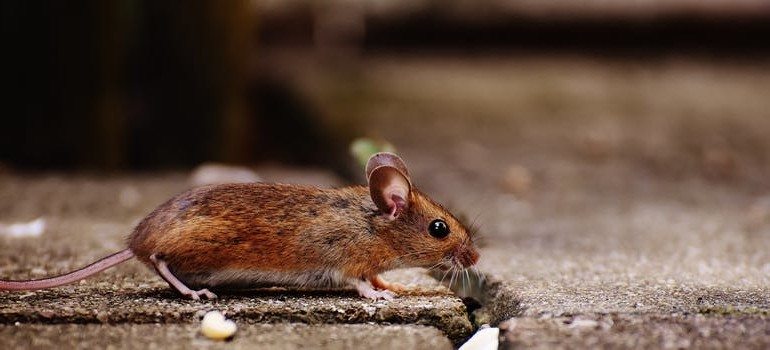Get A Free Quote
If you’ve noticed signs of mice or heard them scurrying around your home, you are wondering how and where they are entering. First, you should be sure you are hearing a mouse and not a rat. Mice are timid creatures and tend to be nocturnal, unless food sources are scarce, and they are forced to forage in the day. Being generally nocturnal is what sets mice apart from rats. Rats tend to sleep in short bursts, making them active at some hours of the night. In comparison to mice, rats are more easily spotted during the daylight hours while foraging. Mouse foraging typically consists of scratching and bumping in walls and ceilings.
Mice chew through walls to get behind your cabinets and climb into drawers. They gnaw through pantry food packages, cereal boxes, pet food bags, and other cardboard or paper packaging. In addition to causing serious damage, mice can carry bacteria and disease in their fur and inside their bellies. In drawers, they have the potential to encounter silverware and other dishes. In air ducts, they shed fur, feces and urine, which can cause pathogens to become airborne. It is never good to have wild mice running around your home. Let’s look at how they’re getting in, and what you can do to seal up those entry points.
How Mice are Entering Your Home
Mice will typically enter your home through cracks and holes in walls, floors, and the foundation. While most homeowners don’t believe cracks or holes could be large enough for a mouse, think again. Due to their adaptable body shape, they are capable of squeezing through some of the smallest openings. It only takes a hole the size of a dime to let most mice into your home. These open crevices are generally not recognized by you, the homeowner, until you have spotted an infestation.
Believing windows are too high for a mouse to reach is a misconception. Gaps in windows, ceilings, or even sewer lines allow entrance for mice. Once entering sewer lines, if drainage pipes are not properly sealed, mice have the option to enter homes via sinks or bathtub drains. It is important to check surrounding plumbing and gas lines as entry holes are typically found in these places.
With fall in full force, and the temperature dropping each day, infestations are on the rise. Tiny gaps in roofing appear due to the combination of heavy snow and cold weather. Mice take advantage of these gaps and make them bigger through chewing and squeezing. Once the mouse initially enters, an infestation is quick to follow. Mice are social creatures by nature, that proliferate quickly resulting in populations exceeding 200 in a matter of months.
Five ways to keep mice from your home:
- Regularly make repairs. If you don’t have the money to hire a handyman or get the materials to keep on top of repairs, consider other measures to seal rotted holes, cracks and openings. A caulking gun is a great tool for temporarily filling entry points. We recommend leaving this to a pest management professional, though, who are trained in identifying and sealing these types of entrances.
- Ensure all your windows and doors can close fully and properly. With this, check all screens for chew marks, or openings large enough for mice. Once inside your wall voids, they will be breeding inside your home–and mice breed faster than rabbits.
- Don’t let mice get to your eaves and roof line as these areas are more vulnerable. Install deterrents like mesh in downspouts and pointed barriers on power wires that attach to your house. Additionally, cut back tree limbs that allow mice to leap onto your roof.
- Don’t leave food sources in your yard. Trash should be sealed And pet food should be stored inside. Make sure that barbecue items are brought back inside after use. Store food in glass or metal containers within your cabinets.
- Partner with a pest control company, such as Wil-Kil Pest Control, to take control of a rodent infestation and get expert advice on your specific situation. We can point out weaknesses that are unique to your home, offer exclusion tips, and provide services if needed.
While these five quick-fix service points may aid you in temporarily ridding your home of mice, it is important to note that trained pest management professionals can exclude these pests further. Wil-Kil Pest Control’s team is certified to understand and identify where rodents can enter the premise of a home, and areas that are often missed by an untrained eye. Our exclusion services will assist in removing your current infestation and secure your home moving forward to prevent future infestations. Contact us today to get started in your home’s mouse exclusion process.


